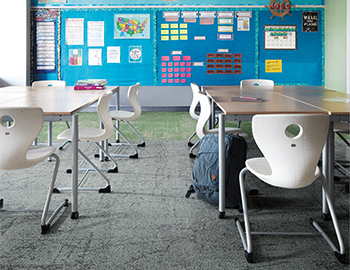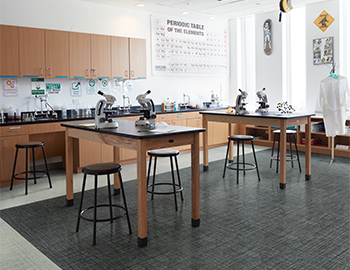Climate change is a topic of increased focus as national headlines and reports call for the reversal of global warming to provide healthy environments for generations to come. As the world continues to be plagued with natural disasters, like the devastating wildfires in California, harmful air quality, warming oceans and more, it is critical to educate the global population about the impact rising temperatures have on the planet and human health. Where to start? With the next generation of climate activists – students.
K-12 school districts play a vital role in increasing student awareness of climate change to inspire and foster this next generation of activists who will continue to prioritize attaining a climate fit for life.
By the time students reach high school graduation, they have accumulated 15,000-plus hours in school, signifying a large opportunity for educators to create stewards of our carbon footprint. The United Nations realized this opportunity in its 2030 Agenda for Sustainable Development, which provides a blueprint for peace and prosperity for people and our planet. The agenda contains a stand-alone goal for education systems, advocating sustainable development issues, such as climate change and biodiversity, in teaching and learning.

According to a study from the North American Association for Environmental Education, sustainability education is effective in academics and climate activism. The study found that incorporating an environmentally-focused education fosters critical thinking, personal growth and life-building skills, as well as enhanced academic performance and civic engagement. An increase in positive environmental behaviors is also a direct result of a sustainably-enriched curriculum, such as participation in community clean-ups and improved recycling efforts.
Educational Facilities & Climate Change
In tandem with integrating sustainability education into the curriculum, school districts have another opportunity for instilling a commitment toward carbon reduction efforts within their student body – their facilities. School facilities can be instrumental – or detrimental – in lowering a school’s overall carbon footprint and impacting public health.
It is critical to address the carbon footprint of built spaces, especially as the building and construction sector is responsible for nearly 40% of global greenhouse gas (GHG) emissions. This marks a significant opportunity for districts to create a healthier world for their students.
Embodied carbon, or the carbon footprint of material, has become an impactful opportunity for the built environment. Embodied carbon considers all GHG emissions throughout a product’s lifecycle, including the product’s value chain and manufacturing, and is the carbon impact of new building and renovation projects before they’re operational, unable to be reduced over time. In fact, embodied carbon is especially urgent to recognize as it contributes 11% of total GHG emissions globally.
Performance outcomes are also a key factor to consider when developing educational facilities. Integrating a sustainable approach can increase performance outcomes for students, teachers and faculty. For instance, in a recent study of green schools, facilities designed with climate in mind see absenteeism reduced by 87%, a 74% increase in ability to attract and retain and teachers, and a 72% increase in community image.
These statistics emphasize the importance of specifying green building materials, which can further contribute toward overall sustainability objectives and help lower an institution’s carbon footprint. K-12 schools and districts can further provide evidence of their environmental commitment through specifying low-carbon materials, in turn, contributing to the sustainability of their facilities.
For example, every 20,000 square feet of Interface’s carbon neutral flooring products sold is equivalent to reversing the emissions of a car traveling 64,516 miles, or 2,926 U.S. gallons of gasoline not being consumed, marking a significant contribution in reversing global warming.

This is just one of the many reasons why educational institutions should specify low embodied carbon building materials to reduce the greenhouse gas emissions impact of their facilities. Should schools want to prove their sustainability efforts further, they can opt for carbon negative building materials, which store carbon, prevent its release into the atmosphere and foster a healthier world.
How to Identify Low-Carbon Vendors and Products
Identifying vendors and manufacturers that align with the school’s sustainability goals is essential to reduce the environmental impact of their built spaces, especially when considering long-term commitments like building materials.
So, how can K-12 systems and school districts effectively identify vendors that align with their sustainability objectives? The following questions for manufacturers can help guide the decision:
- Do you have goals to remove toxic chemicals from your products? Anything beyond that?
- What percentage of raw material inputs for your total product portfolio comes from recycled content or biobased materials?
- What is the most important thing you would need to do to cut your products’ carbon footprint by 50% in the next five to 10 years?
When considering different vendors, seeking a better understanding around the sustainable implications of material choice is vital to making a balanced decision. Those looking to better understand their building materials’ potential carbon impact can employ tools and resources to compare the amount of embodied carbon associated with each product, such as the free Embodied Carbon in Construction Calculator (EC3) tool. EC3 allows users to do side-by-side carbon comparisons of individual materials, empowering them to specify and procure low-carbon options based on available products.
Another consideration when specifying products is what end-of-life considerations have been instituted by the manufacturer. To gauge the quality of a vendor’s program, take into account the following:
- How long is the product expected to stay in service?
- Are products taken back actually recycled?
- What percentage of old products can be repurposed?
- What is the amount of new product actually produced from old product?
- What third party is used to verify their recycling process claims?
By aligning sustainability goals and values with these vendors, districts can further move the sustainability needle in favor of carbon neutrality and solid waste diversion.
Improving Student Outcomes with Sustainable Design
Results indicate that educational facilities largely influence students, teachers and faculty’s productivity and health. One recent study found student test scores went up considerably due to improved school conditions when comparing results before and after the renovations.
Committing to specify more sustainable building materials is key to fostering increased public health and wellness in the student body. Climate change is the greatest threat to human health of the 21st century, making it a priority for schools and districts to address climate change. Furthermore, emphasizing the importance of sustainability through enriched curriculum can lead to improved student health and performance, while inspiring the next generation to lead a more sustainable life and contribute to a more sustainable world.

